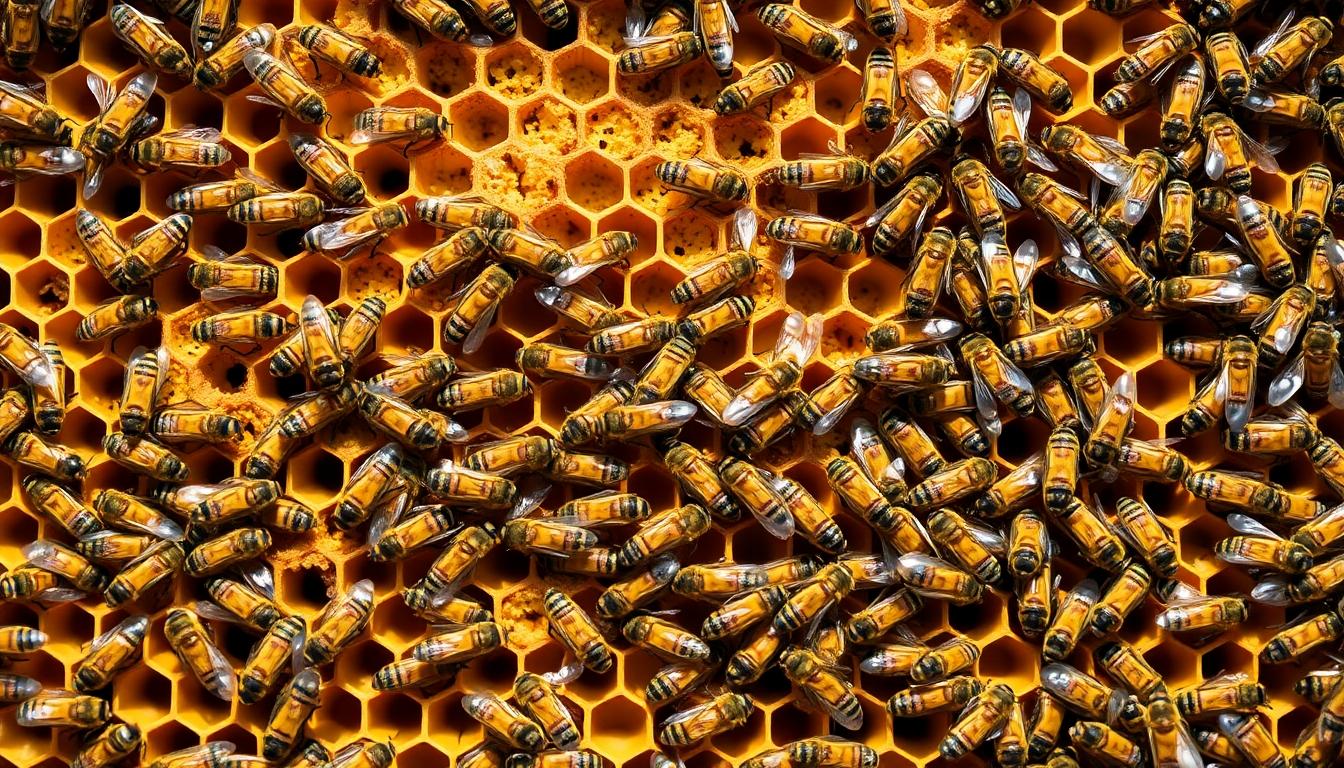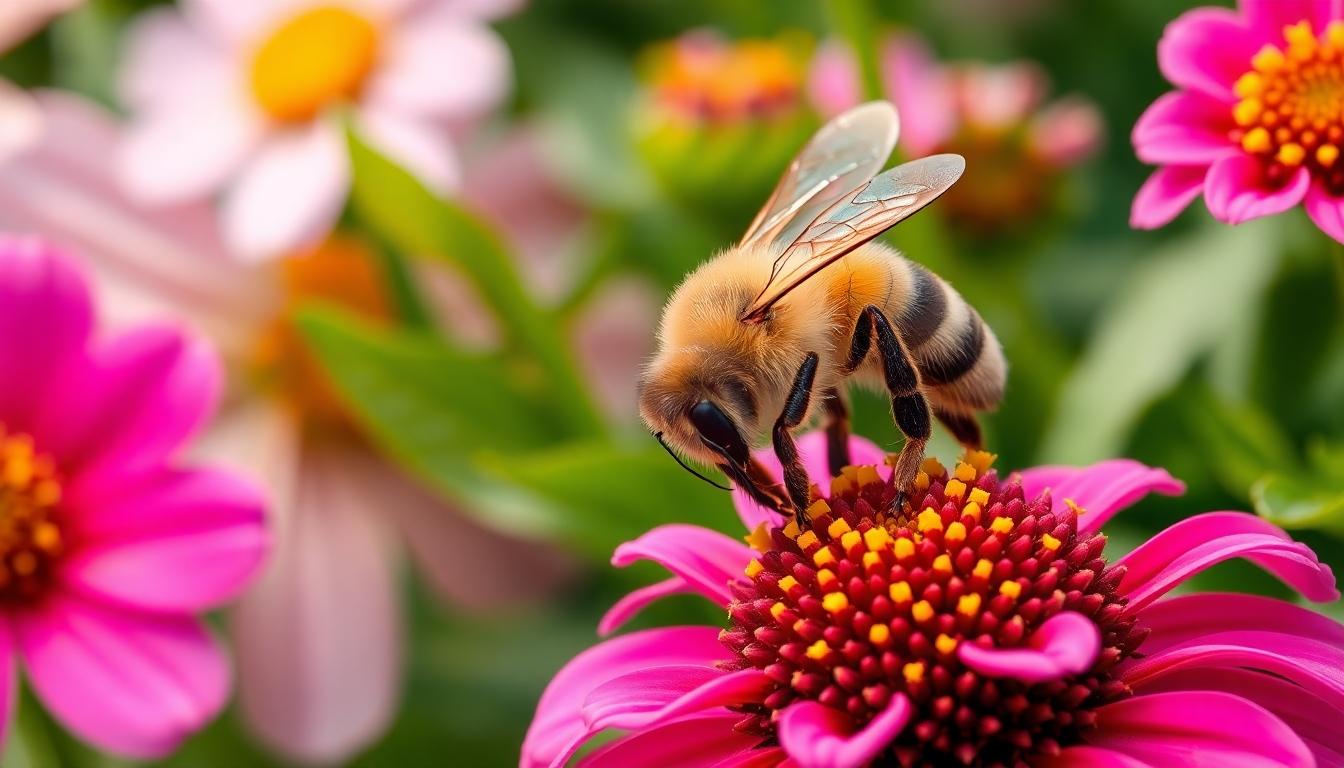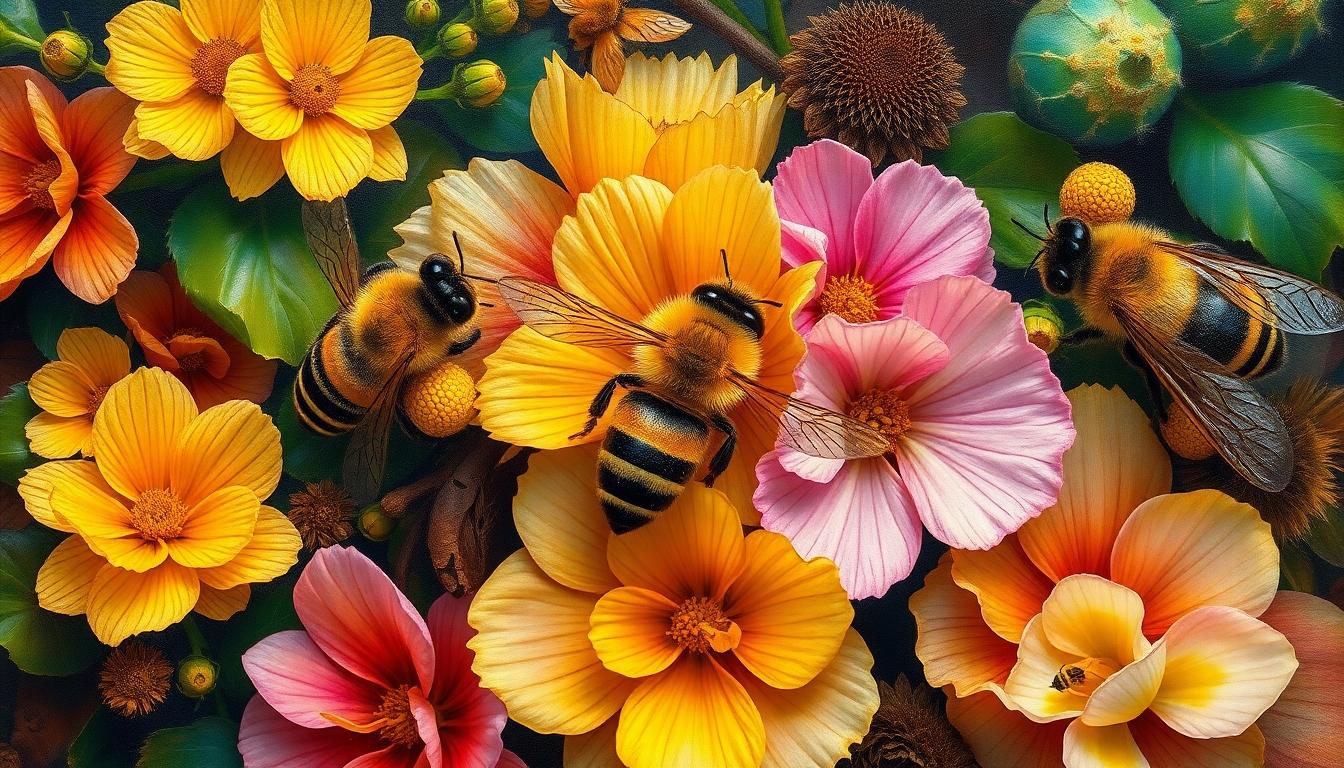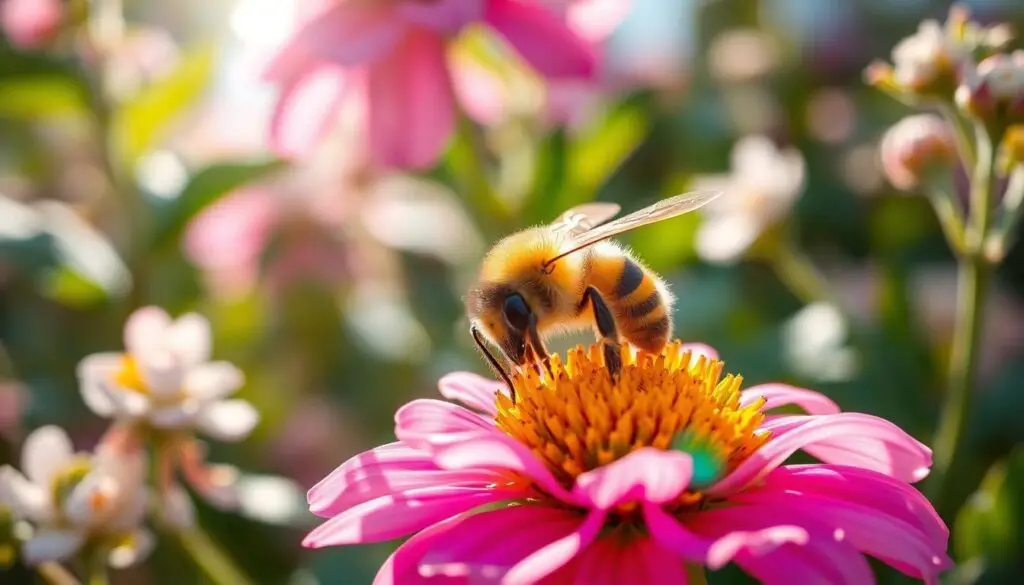Honey bees have fascinated humanity for thousands of years, representing far more than just producers of sweet golden nectar. These remarkable creatures embody powerful symbolism across cultures, religions, and ancient traditions worldwide. From productivity and community to divine messages and spiritual enlightenment, the humble bee carries profound meaning that continues to resonate with us today.
We’ve explored the rich tapestry of honey bee symbolism to uncover why these tiny insects hold such important places in our collective consciousness. Whether you’re drawn to bees as spirit animals, curious about their appearance in dreams, or interested in their representation in various mythologies, understanding bee symbolism offers valuable insights into our own lives and relationships. Join us as we investigate into the symbolic industry of these extraordinary pollinators.
The Cultural Significance of Honey Bees Throughout History
Ancient Egyptian Reverence for Bees
Ancient Egyptians considered honey bees sacred creatures associated with the sun god Ra. Bees appeared in hieroglyphics dating back to 2400 BCE, symbolizing the pharaoh’s authority over Lower Egypt. Temple walls often displayed bee imagery, connecting these industrious insects to divine royalty and resurrection. Honey itself was regarded as tears from Ra, making it a precious substance used in religious ceremonies, medicinal treatments, and mummification processes. Egyptian priestesses were sometimes called “Bee Priestesses,” further cementing the spiritual connection between bees and ancient Egyptian religious practices.
Bees in Greek and Roman Mythology
Greek mythology linked bees to the story of Zeus, who was fed honey as an infant by nymphs in a cave on Mount Ida. The goddess Artemis incorporated bee symbolism in her identity as the queen protector of nature and wildlife. Roman writers like Virgil dedicated entire sections of literature to beekeeping, viewing bee colonies as perfect models for human civilization. Honey was considered the “food of the gods” in classical antiquity, used in offerings to deities and as currency in trade. Temples dedicated to Aphrodite featured bee priestesses called “Melissae,” reflecting the belief that bees embodied divine feminine energy.
Bee Symbolism in Asian Traditions
Chinese culture traditionally viewed bees as symbols of hard work, prosperity, and good luck for over 7,000 years. Honey bees appear in ancient Chinese texts representing ideal social order and harmony within communities. Hindu traditions associate bees with love god Kama, who carries a bow with a string made of bees. Buddhist teachings use the relationship between bees and flowers as metaphors for ideal human interactions—taking what’s needed without causing harm. Japanese folklore portrays bees as messengers between the human industry and the spirit area, symbolizing diligence and collective wisdom across generations.
Christian and Medieval Bee Symbolism
Medieval Christianity adopted bee imagery to represent ideal Christian virtues like chastity, order, and industriousness. Monastery gardens often included beehives, with monks developing sophisticated beekeeping practices throughout Europe. Beeswax candles became essential elements in church rituals, considered the purest light source for sacred spaces. Religious texts compared bees to the Virgin Mary due to the misconception that bees reproduced without mating. Illuminated manuscripts featured bees as symbols of resurrection, connecting their emergence in spring to Christ’s rebirth story.
Bees in European Heraldry and Politics
Royal families across Europe incorporated bee imagery into their coats of arms beginning in the 12th century. Napoleon Bonaparte famously adopted the bee as his personal emblem, replacing the fleur-de-lis to symbolize his new dynasty’s industriousness. Manchester, England uses the worker bee as its official symbol, representing the city’s hardworking industrial heritage since the Industrial Revolution. Finnish national identity embraces bee symbolism to represent perseverance through harsh conditions and community resilience. Beehives appear in Masonic imagery as symbols of organized society and the virtues of coordinated collective effort.
Honey Bees as Symbols of Community and Social Order

Honey bees represent idealized social structures through their meticulously organized colonies. Their communal organization demonstrates efficient hierarchy and specialization that humans have admired and sought to emulate for centuries.
The Hive as a Model for Human Society
The beehive exemplifies a perfect blueprint for societal organization with its remarkable efficiency and waste-free environment. Ancient Greek and Roman writers frequently referenced bee colonies as validation for concepts of stability, thrift, and industry in human governance. During times of social upheaval in seventeenth-century Europe, bee imagery promoted poverty-alleviating social order by emphasizing communal duty over individualism. The bees’ collective workflow optimization and resource management continue to inspire modern organizational theories and social structures. Their natural propensity for cooperation serves as a powerful metaphor for human aspirations toward communal efficiency and moral governance.
Queens, Workers, and Drones: Hierarchy and Roles
The colony’s division of labor illustrates perfect role specialization with each bee type contributing uniquely to collective survival. Queens function as reproductive centers, embodying centralized authority while producing eggs to ensure colony continuation. Workers, sterile females, perform multiple critical tasks including foraging, nursing young, and maintaining hive infrastructure with remarkable altruistic behaviors like self-sacrifice for colony defense. Drones, the male bees, serve exact reproductive purposes, highlighting how the colony selectively prioritizes roles crucial for survival. This natural hierarchy mirrors societal ideals of responsibility and interdependence across cultures and time periods. Religious contexts often incorporate bee imagery to represent divine wisdom and resurrection symbolism, while cultural narratives use their biological traits to promote cooperation, diligence, and social harmony as foundational elements of thriving communities.
Divine Messengers: Honey Bees in Religious Symbolism

Honey bees have transcended their biological significance to become powerful sacred symbols across many civilizations. Their structured societies and remarkable honey production capabilities established them as symbols of divine order, spiritual purity, wisdom, and cosmic connection throughout religious history.
Bees in Ancient Egyptian Mythology
Ancient Egyptians revered bees as divine creatures intimately connected to royalty and creation myths. These remarkable insects were directly associated with the sun-god Ra, with beliefs suggesting bees originated from Ra’s tears, symbolizing life’s regenerative power. Pharaohs incorporated bee imagery to represent their authority specifically in Lower Egypt, demonstrating the insect’s political significance. Archaeological evidence reveals honey placed in tombs as both sacred offerings and medicine, highlighting its dual religious and practical importance. The “Salt Magical Papyrus,” a important ancient Egyptian text, further emphasizes bees’ central role in religious rituals, particularly those connected to abundance, healing, and spiritual purification.
Christian Symbolism of Honey and Bees
Early Christian traditions embraced bee symbolism to represent essential spiritual virtues and divine principles. Honey functioned as a powerful metaphor for Christ’s sweetness, divine blessings, and the abundant promise of the Promised Land described in biblical texts. Christian communities viewed beehives as perfect models of an idealized Christian society, with each bee’s role reflecting proper moral order and divine harmony. Bees themselves embodied resurrection themes through their seasonal patterns, representing spiritual rebirth and transformation. The industrious nature of these insects reinforced Christian teachings on moral discipline, diligence, and adherence to divine order. Christian symbolism parallels Ancient Greek traditions where bees served as divine messengers, with priestesses called Melissae (meaning “bees”) maintaining sacred temples and performing essential rituals. This cross-cultural reverence demonstrates bees’ enduring power as symbols of sacred labor and cosmic interconnectedness across diverse religious traditions.
The Industrious Bee: Symbols of Hard Work and Productivity

Honey bees epitomize industriousness in nature, serving as powerful symbols of diligence, perseverance, and collective achievement across cultures. Their tireless work ethic and remarkable productivity have inspired human societies for millennia.
Honey Bees in Corporate Logos and Branding
Corporate entities frequently incorporate honey bee imagery into their visual identities to evoke qualities of unity, dedication, and productivity. The bee’s complex hive structure represents community cohesion and organizational efficiency, making it appealing to companies that value teamwork and collaboration. Businesses like Beech-Nut and Honeywell have embraced bee symbolism in their logos, effectively communicating their commitment to industriousness and cooperation. Bees’ association with honey—a substance symbolizing warmth, sweetness, and golden opportunity—makes them particularly attractive for brands in natural products and food industries. These companies leverage the positive connotations of bees to create memorable brand identities that resonate with consumers seeking authenticity and natural goodness.
The Bee’s Work Ethic as Inspiration
The remarkable work ethic of honey bees provides a compelling model for human productivity and determination. These tiny creatures travel impressive distances—often up to three miles from their hive—visiting countless flowers to collect nectar for honey production. A single worker bee typically visits 50-100 flowers during each collection trip, demonstrating extraordinary dedication to its task. Their ability to transform nectar from diverse floral sources into nutritious honey exemplifies transformation through persistent effort. Organizations frequently reference this natural example of productivity when motivating teams to pursue goals with determination and collaborative spirit. The bee’s capacity to accomplish important results through consistent, focused effort serves as a powerful reminder of how steady work leads to sweet success.
Honey Bee Symbolism in Art and Literature

Honey bees have served as powerful symbols throughout art and literature, representing wisdom, communication, and natural balance across diverse cultural expressions. Their organized societies and productive roles have inspired creators to use them as metaphors for human values and social structures.
Bees in Poetry and Prose
Literary works from the 18th century frequently employed bees as symbols for societal organization and collective harmony. Poets drew parallels between bee colonies and human communities, highlighting the insects’ diligence and cooperation as models for social behavior. Their community-oriented nature made them perfect metaphors for industriousness in many written works. These industrious insects appear in literature as representations of wisdom and communication, reflecting humanity’s longstanding fascination with their structured societies and productive contributions to the natural industry.
Visual Representations in Paintings and Sculptures
Artistic depictions of honey bees span centuries and diverse cultural traditions, capturing their symbolic significance in visual form. The 2nd century CE sculpture of Artemis of Ephesus features bee imagery as a potent symbol of fertility, connecting the insect to ancient polytheistic worship. Lucas Cranach the Elder’s 1472 painting “Venus With Cupid Stealing Honey” uses bees to explore themes of love and temptation, creating a visual narrative about desire’s sweet rewards and painful consequences. Juan de Valdes Leal elevated bee symbolism to spiritual heights in his 1673 work “The Miracle of the Bees,” emphasizing their connection to divine intervention and miraculous occurrences.
Gianlorenzo Bernini incorporated bee imagery in his monumental “Tomb of Pope Urban VIII” (1627-1647), where the insects symbolize Christian eloquence and divine wisdom. Ancient Egyptian artisans carved bee hieroglyphs as part of royal titles for pharaohs, visually connecting these rulers to concepts of health, wealth, and societal order. These artistic representations demonstrate how honey bees have consistently inspired visual artists to explore themes of community, productivity, and spiritual significance across cultural boundaries and historical periods.
Modern Interpretations of Honey Bee Symbolism

Today’s understanding of honey bee symbolism has evolved to reflect contemporary environmental challenges and social values. Modern perspectives focus on ecological interdependence, conservation efforts, and sustainable community models that address current global concerns.
Environmental Consciousness and Conservation
Environmental stewardship stands at the forefront of modern honey bee symbolism, highlighting our collective responsibility toward fragile ecosystems. Bees now serve as powerful indicators of ecological health, with their role in pollinating approximately one-third of global food production making them essential to human survival. Declining bee populations function as a “canary in the coal mine,” warning us about broader environmental crises that threaten biodiversity worldwide.
Urban beekeeping movements have emerged as practical responses to these concerns, transforming bees into ambassadors for sustainable agriculture and habitat restoration. Pollinator-friendly gardening initiatives encourage individuals to create safe havens for bees in their communities, connecting personal actions to global conservation efforts. These grassroots approaches demonstrate how bee symbolism has evolved from abstract representation to actionable environmental advocacy.
Conservation campaigns effectively merge practical measures like reducing pesticide use and planting native flora with symbolic messaging that positions bee protection as an entry point to wider environmental activism. The interdependence between humans and pollinators emphasizes our connection to natural systems, reinforcing the urgent need for protective measures and sustainable practices.
Cultural Resilience and Community Solidarity
Honey bees continue to represent cultural resilience in modern contexts, particularly in communities facing adversity. Manchester, England provides a compelling example of this symbolism, where the bee emblem traditionally represented the city’s industrial heritage during the Industrial Revolution. Following the 2017 terrorist bombing, Manchester residents embraced the bee symbol with renewed significance as a powerful representation of collective rebuilding and community solidarity.
This modern application demonstrates how traditional bee symbolism adapts to contemporary challenges while maintaining core values of unity and perseverance. The Manchester bee transcended its historical meaning to become a symbol of resilience against tragedy, showing how bee imagery continues to evolve while retaining its fundamental connection to community strength.
Systems Thinking and Organizational Models
Cooperative honey bee colonies now inspire systems-thinking approaches to complex challenges like climate action and organizational management. Their structured yet adaptable societies serve as models for leadership frameworks that balance efficiency with flexibility in modern business environments. Organizations increasingly reference bee colonies when developing team structures that promote both productivity and adaptability.
Bees’ remarkable ability to communicate complex information, make collective decisions, and maintain social cohesion offers valuable insights for human institutions facing uncertainty and change. Their cooperative problem-solving abilities demonstrate how community-driven answers often prove more effective than individualistic approaches, particularly when addressing systemic ecological and social challenges.
Spiritual and Ethical Dimensions
Traditional spiritual interpretations of bees have evolved to include modern ethical dimensions about environmental stewardship. Religious contexts still reference bees as symbols of divine order and natural harmony, but increasingly frame their preservation as a moral imperative rather than just a metaphorical teaching tool. The protection of pollinators is now presented as an ethical responsibility that crosses denominational and cultural boundaries.
This shift reflects broader movements toward faith-based environmentalism, where religious communities increasingly view ecological protection through spiritual lenses. Bee conservation efforts often bridge diverse communities through shared values of stewardship and respect for natural systems, creating unexpected alliances among groups with different worldviews but common environmental concerns.
Conclusion
Honey bees stand as timeless symbols transcending their ecological role to represent our highest human aspirations. Their imagery continues to evolve while maintaining core values of community cohesion diligence and sacred purpose.
As we face modern environmental challenges bees remind us of our interconnectedness with nature and each other. Their symbolism now extends beyond ancient cultural meanings to represent urgent calls for sustainability and collective action.
We’ve seen how these remarkable creatures have inspired everything from religious devotion to corporate values across millennia. Their enduring symbolic power lies in their perfect balance of individual contribution and community benefit – a model we’re still striving to achieve in our own societies.
The honey bee’s journey through human consciousness continues to teach us about productivity harmony and our place within the natural industry.
Frequently Asked Questions
What does the honey bee symbolize in ancient Egyptian culture?
In ancient Egyptian culture, honey bees were considered sacred creatures linked to the sun god Ra. They symbolized pharaonic authority and were deeply connected to royalty. Bees were believed to have originated from Ra’s tears and were incorporated into royal imagery. Honey was also used in tombs as sacred offerings, highlighting the bee’s spiritual significance in Egyptian religious practices.
How were bees viewed in Greek and Roman mythology?
In Greek and Roman mythology, bees were associated with divine figures and seen as embodiments of civilization and nature. Ancient writers used bee colonies as examples of stability and industry in governance. Bees represented the ideal balance between natural order and human society, serving as models for political organization and communal living.
What role do honey bees play in Christian symbolism?
In Christian traditions, bees symbolize virtues like chastity, industriousness, and spiritual purity. Beeswax candles held significant importance in religious rituals, representing Christ’s light. The beehive structure was seen as a metaphor for the ideal Christian community, with honey serving as a symbol of divine blessings and God’s word. Early Christians adopted bee imagery to represent spiritual virtues.
How do honey bees represent community and social order?
Honey bee colonies serve as a model for human society through their highly organized structure. The beehive demonstrates efficiency and waste-free environment management. The division of labor between queens, workers, and drones mirrors societal ideals of responsibility and interdependence. This natural hierarchy exemplifies cooperation, diligence, and social harmony that human communities aspire to achieve.
Why are honey bees considered symbols of productivity?
Honey bees epitomize tireless work ethic, perseverance, and collective achievement. They travel great distances to collect nectar and transform it into honey through consistent effort. Their remarkable productivity has inspired human societies for millennia, serving as a natural example of how dedicated work leads to success. Many organizations reference bee productivity to motivate teams and illustrate the value of consistent effort.
How are honey bees represented in art and literature?
Throughout history, honey bees have appeared in art and literature as symbols of wisdom, communication, and natural balance. Literary works from the 18th century used bees as metaphors for societal organization. Artistic depictions range from ancient sculptures like the Artemis of Ephesus to Renaissance paintings such as Lucas Cranach’s “Venus With Cupid Stealing Honey,” exploring themes of community, productivity, and spiritual significance.
What do honey bees symbolize in modern environmental contexts?
In contemporary society, honey bees serve as powerful symbols of environmental stewardship and ecological health indicators. They highlight the importance of conservation efforts and sustainability. Urban beekeeping movements and pollinator-friendly initiatives represent grassroots responses to environmental concerns. Bee symbolism has evolved into actionable advocacy for protecting natural systems and promoting sustainable practices.
How do honey bees represent cultural resilience?
Honey bees symbolize cultural resilience particularly in communities facing adversity. In Manchester, the bee emblem represents collective rebuilding and solidarity following tragedy. The cooperative nature of bee colonies inspires communities to work together through challenges. Their ability to adapt and thrive collectively serves as a powerful metaphor for human communities overcoming hardship through unity and perseverance.
What business lessons can be learned from honey bee colonies?
Honey bee colonies inspire systems-thinking approaches in organizational management. Their efficient division of labor promotes workplace productivity and adaptability. Companies like Beech-Nut and Honeywell incorporate bee imagery in their branding to communicate teamwork, dedication, and unity. The bee colony model demonstrates how specialized roles working in harmony create organizational efficiency while maintaining flexibility to respond to changing conditions.
How has the spiritual significance of bees evolved in contemporary society?
The spiritual significance of bees has evolved to encompass environmental protection as a moral imperative. Faith-based environmentalism now incorporates bee conservation as part of religious stewardship responsibilities. Diverse spiritual communities unite around shared values of respect for natural systems. This evolution reflects a broader integration of ecological consciousness with traditional spiritual values, reinforcing bees’ enduring significance in both historical and contemporary religious narratives.










